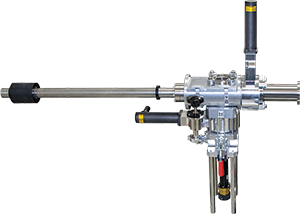
If you’re looking for a simple way to transfer samples from a glovebox, drybox, or other inert atmosphere container to a high-vacuum, cryogenic probing environment, this may be of interest to you: a new specialized suitcase (PS-SC-CPX) for use with the load-lock assembly (PS-LL-CPX) that can be installed on our CPX, CPX-VF, or CRX-VF probe station.
Featuring a vacuum flange adaptable for various standard glove box fittings, the suitcase is designed to enable quick transfer of a sample between controlled environments — without exposing the sample to the ambient environment. A sample is loaded into the sample carriage of the suitcase, and once the suitcase is mounted on the underside of the load-lock chamber, the sample can be shuttled to the cold stage with ease. This mechanism protects the active material surfaces or delicate organic materials from atmospheric contamination — a capability that is crucial in a number of material characterization applications, including research into atomically thin transition metal dichalcogenide (TMD) structures. As noted in an earlier blog post, TMDs can be significantly affected by such exposure.
For more about the suitcase and how the PS-LL-CPX/PS-SC-CPX combination can be specified for your research or test application, please contact us at sales@lakeshore.com.
Also, note the suitcase can be field installed on probe stations already configured with a load-lock. So, in addition to being able to exchange samples without warming the radiation shields or breaking vacuum, which the load-lock provides, you can take it a step further and help ensure that highly sensitive wafers remain isolated in a non-reactive environment from the point at which they’re processed (using spin coating, vapor deposition, etc.) all the way to the probing environment.
